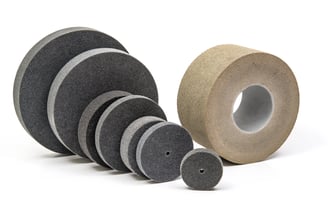The Key to Precision and Profit: Choosing the Right Abrasives
Unlock the secrets of precision machining and finishing with this comprehensive guide to abrasive selection. Learn how to choose the right abrasives for grinding, considering material compatibility, desired finish, and bond type. Achieve optimal efficiency, cost savings, and superior results.
Anup Kumar
3/8/20243 min read
Precision Machining & Finishing: The Key to Success with Abrasives
What are Abrasives?
Abrasives are hard materials composed of tiny, sharp cutting edges called grains. When applied with force, these grains wear away other materials through cutting, scratching, and chipping.In manufacturing, abrasives are essential for cutting, finishing, and achieving precise tolerances. This guide focuses on selecting the right abrasives for grinding, covering a range from traditional to advanced materials and bonds for optimized efficiency, cost, and quality.
Grinding Wheels: A Powerful Abrasive Tool
Grinding wheels are a type of bonded abrasive where the grains are held together in a rigid shape by a bonding material. They're designed for heavy-duty material removal, shaping, and achieving dimensional accuracy.
Types of Abrasives
Two main types of abrasives exist: bonded abrasives (including grinding wheels, discs, and segments), which are best for substantial material removal and shaping, and coated abrasives (abrasive grains adhered to flexible backings like belts or sheets), which are ideal for sanding, smoothing, and polishing.
Choosing Abrasives for Grinding
Several factors are crucial when selecting abrasives for grinding. First, consider material compatibility, matching the abrasive's hardness to the workpiece material. Key properties to factor in are tensile strength and overall hardness. For example, aluminum oxide is best for materials with high tensile strength like most steels, while silicon carbide is ideal for materials with lower tensile strength. Super-hard materials often require specialized abrasives like ceramic or CBN.
The desired finish, measured as surface roughness (Ra), also dictates abrasive choice. Use coarse grits for rough shaping and fine to ultra-fine grits for smooth, precise surfaces.
Finally, the bond type, or the material that holds the abrasive grains together, impacts the wheel's performance. Common options include vitrified (strong and rigid), resinoid (flexible and durable),rubber (for very smooth finishes).Ceramic and CBN for Specialized abrasives for extremely hard materials.
Understanding Grinding Wheel Codes
Grinding wheels have a standardized code to tell you everything about their composition. A common code looks like this: A 60 K 5 V 17. Each part of the code represents a specific characteristic:
Abrasive Type: Indicates the type of abrasive material used. Example: A = Aluminum Oxide, C = Silicon Carbide
Grit Size: Measures how coarse or fine the abrasive is. Example: 60 represents a medium grit size. Lower numbers are coarser, higher numbers are finer.
Grade: Describes the hardness of the bond holding the grains. Example: K represents a medium hardness bond. Softer grades use earlier letters (e.g., E), harder grades use later letters (e.g. Z)
Structure: Relates to the density of the grain spacing within the wheel. Example: 5 represents a moderately open structure.
Bond Type: The material that holds the abrasive grains together. Example: V = Vitrified (a common, rigid bond)
Manufacturer's Designation: (Optional) Some manufacturers add their own code for specific variations (e.g., 17)
Learn to understand these codes to make informed decisions.
Optimizing Grinding Wheel Selection
For precision grinding, consider additional constant factors like the material being ground, the amount of stock to be removed, the area of contact, and the type of grinding machine being used. Also important are variable factors such as wheel speed, work speed, the condition of the machine, and operator skill level.
Specialized Grinding Processes
Centerless grinding, for cylindrical components, uses regulating wheels and requires abrasives tailored for achieving very precise diameters and roundness.
Beyond Grinding
Advanced finishing processes, like honing, lapping, and superfinishing, may be employed for even higher levels of precision.
Innovations in Bond Technology
Researchers are continuously developing new bond materials to enhance grinding wheel performance, reduce costs, and meet increasingly demanding precision requirements.
The Bottom Line
Understanding abrasives, including bond types, is crucial for efficient, cost-effective grinding. This knowledge helps you make choices that improve your productivity and final product quality.


AVB GLOBAL EXIM is the registered trademark of AVB GLOBAL.© 2024 AVB GLOBAL EXIM.All Rights Reserved.



